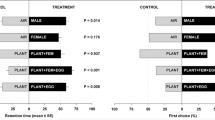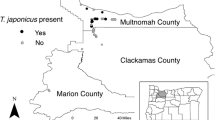Abstract
Caterpillar hairs are thought to act as a physical barrier against natural enemies, including parasitoids. However, very few studies have experimentally demonstrated how hairs protect caterpillars from parasitoid oviposition. To clarify the importance of caterpillar hairs as an anti-parasitoid defence, we observed the generalist endoparasitoid Meteorus pulchricornis (Hymenoptera: Braconidae) attacking both smooth and hairy caterpillars under laboratory conditions. A female Meteorus pulchricornis uses its ovipositor to inject venom and lay a single egg inside host larvae. We placed a smooth Spodoptera litura (Lepidoptera: Noctuidae) caterpillar or a hairy Lymantria dispar japonica (Lepidoptera: Erebidae) caterpillar in front of parasitoid females. We observed that 100 % and 84 % of the parasitoids could successfully stab their ovipositors into the smooth larvae of S. litura and first instars of the hairy caterpillar L. dispar japonica, respectively. However, only 24 % of parasitoids could successfully stab their ovipositors into second-instar L. dispar japonica. A higher rate of successful stabs (94 %) by parasitoids was obtained by cutting the hairs of second instar L. dispar japonica much shorter than the parasitoid ovipositor. The results demonstrate that the long, thick hairs of second and later instars of L. dispar japonica function as a physical barrier against parasitoid oviposition.


Similar content being viewed by others
References
Bowers MD (1993) Aposematic caterpillars: life-styles of the warningly colored and unpalatable. In: Stamp NE, Casey TM (eds) Caterpillars: ecological and evolutionary constraints on foraging. Chapman & Hall, New York, pp. 331–371
Casey TM, Hegel JR (1981) Caterpillar setae: insulation for an ectotherm. Science 214:1131–1133. doi:10.1126/science.214.4525.1131
Castellanos I, Barbosa P, Zuria I, Tammaru T, Christman MC (2011) Contact with caterpillar hairs triggers predator-specific defensive responses. Behav Ecol 22:1020–1025. doi:10.1093/beheco/arr085
Dyer LA (1995) Tasty generalists and nasty specialists? Antipredator mechanisms in tropical lepidopteran larvae. Ecology 76:1483–1496. doi:10.2307/1938150
Dyer LA (1997) Effectiveness of caterpillar defense against three species of invertebrate predators. J Res Lepid 34:48–68
Dyer LA, Gentry G (1999) Predicting natural-enemy responses to herbivores in natural and managed systems. Ecol Appl 9:402–408. doi:10.1890/1051-0761(1999)009[0402:PNERTH]2.0.CO;2
Edmunds M (1974) Defense in animals. Longman, Harlow
Elkinton JS, Liebhold AM (1990) Population dynamics of gypsy moth in North America. Annu Rev Entomol 35:571–596. doi:10.1146/annurev.en.35.010190.003035
Emlen DJ (2014) Animal weapons: the evolution of battle. Holt, New York
Fuester RW, Taylor PB, Peng H, Swan K (1993) Laboratory biology of a uniparental strain of Meteorus pulchricornis (Hymenoptera: Braconidae), an exotic larval parasite of the gypsy moth (Lepidoptera: Lymantriidae). Ann Entomol Soc Am 86:298–304. doi:10.1093/aesa/86.3.298
Greeney HF, Dyer LA, Smilanich AM (2012) Feeding by lepidopteran larvae is dangerous: a review of caterpillars’ chemical, physiological, morphological, and behavioral defenses against natural enemies. Invertebrate Survival J 9:7–34
Gross P (1993) Insect behavioral and morphological defenses against parasitoids. Annu Rev Entomol 38:251–273. doi:10.1146/annurev.en.38.010193.001343
Harvey JA, Sano T, Tanaka T (2010) Differential host growth regulation by the solitary endoparasitoid, Meteorus pulchricornis in two hosts of greatly differing mass. J Insect Physiol 56:1178–1183. doi:10.1016/j.jinsphys.2010.03.018
Kenis M, Vaamonde CL (1998) Classical biological control of the gypsy moth, Lymantria dispar (L.), in North America: prospects and new strategies. In: McManus ML, Liebhold AM (eds) Proceedings: population dynamics, impacts, and integrated management of forest defoliating insects. USDA Forest Service Northeastern Research Station, Radnor, pp. 213–221
Knapp R, Casey TM (1986) Thermal ecology, behavior, and growth of gypsy moth and eastern tent caterpillars. Ecology 67:598–608. doi:10.2307/1937683
Maetô K (1989) Systematic studies on the tribe Meteorini (Hymenoptera, Braconidae) from Japan V. The pulchricornis group of the genus Meteorus (1). Jap J Entomol 57:581–595
Minami T, Ishii M, Temma K (1999) Difference in parasitoid complex of gypsy moth, Lymantria dispar L. (Lepidoptera: Lymantriidae), between mountain coppice and urban greenery in Osaka, Japan. Jap J Appl Entomol Zool 43:169–174 (In Japanese with English summary)
Murphy SM, Leahy SM, Williams LS, Lill JT (2009) Stinging spines protect slug caterpillars (Limacodidae) from multiple generalist predators. Behav Ecol 21:253–160. doi:10.1093/beheco/arp166
Pogue MG, Schaefer PW (2007) A review of selected species of Lymantria Hübner [1819] (Lepidoptera: Noctuidae: Lymantriinae) from subtropical and temperate regions of Asia, including the descriptions of three new species, some potentially invasive to North America. United States Department of Agriculture, Forest Health Technology Enterprise Team, Washington
R Development Core Team (2015) R, a language and environment for statistical computing. R Foundation for Statistical Computing, Vienna
Rice WR (1989) Analyzing tables of statistical tests. Evolution 43:223–225
Rota J, Wagner DL (2008) Wormholes, sensory nets and hypertrophied tactile setae: the extraordinary defence strategies of Brenthia caterpillars. Anim Behav 76:1709–1713. doi:10.1016/j.anbehav.2008.06.024
Shimazu M (1991) Lymantria dispar japonica. In: Yushima K et al. (eds) Rearing methods in insects. Nihon Shokubutu Bôeki Kyôkai, Tokyo, pp 172–174 (In Japanese)
Stehr FW (1987) Immature insects, vol 1. Kendall/Hunt, Dubuque
Sugiura S (2016) Bagworm bags as portable armour against invertebrate predators. PeerJ 4:e1686. doi:10.7717/peerj.1686
Sugiura S, Yamazaki K (2006) The role of silk threads as lifelines for caterpillars: pattern and significance of lifeline-climbing behaviour. Ecol Entomol 31:52–57. doi:10.1111/j.0307-6946.2006.00755.x
Sugiura S, Yamazaki K (2014) Caterpillar hair as a physical barrier against invertebrate predators. Behav Ecol 25:975–983. doi:10.1093/beheco/aru080
Suzuki M, Tanaka T (2006) Virus-like particles in venom of Meteorus pulchricornis induce host hemocyte apoptosis. J Insect Physiol 52:602–613. doi:10.1016/j.jinsphys.2006.02.009
Suzuki M, Tanaka T (2007) Development of Meteorus pulchricornis and regulation of its noctuid host, Pseudaletia separata. J Insect Physiol 53:1072–1078. doi:10.1016/j.jinsphys.2007.06.006
Tsutsui Y, Maeto K, Hamaguchi K, Isaki Y, Takami Y, Naito T, Miura K (2014) Apomictic parthenogenesis in a parasitoid wasp Meteorus pulchricornis, uncommon in the haplodiploid order hymenoptera. Bull Entomol Res 104:307–313. doi:10.1017/S0007485314000017
Wagner DL (2005) Caterpillars of eastern North America: a guide to identification and natural history. Princeton University Press, Princeton
Weseloh RM (1976) Reduced effectiveness of the gypsy moth parasite, Apanteles melanoscelus, in Connecticut due to poor seasonal synchronization with its host. Environ Entomol 5:743–746. doi:10.1093/ee/5.4.743
Yamamoto M, Chau NNB, Maeto K (2009) Host movement initiates oviposition behavior of Meteorus pulchricornis, a braconid parasitoid of free-living lepidopteran larvae. Appl Entomol Zool 44:53–59. doi:10.1303/aez.2009.53
Yamanaka H, Nakasuji F, Kiritani K (1972) Life tables of the tobacco cutworm, Spodoptera litura (Lepidoptera: Noctuidae), and an evaluation of the effectiveness of natural enemies. Jap J Appl Entomol Zool 16:205–214 In Japanese with English summary
Zolubas P, Gedminas A, Shields K (2001) Gypsy moth parasitoids in the declining outbreak in Lithuania. J Appl Entomol 125:229–234. doi:10.1046/j.1439-0418.2001.00532.x
Acknowledgments
We thank K Maeto for providing parasitoids and for helpful advice. We also thank M Osawa for providing gypsy moth eggs. Finally, we thank four anonymous referees for their valuable comments on our manuscript. This research was supported by a Grant-in-Aid for Scientific Research (no. 25292034). The experiments also complied with the current laws of Japan.
Author contributions
SS conceived and designed experiments. AK reared both caterpillars and parasitoids in the laboratory. AK and SS performed laboratory experiments. SS analysed the data and wrote the manuscript.
Conflict of interest
The authors declare there are no competing financial interests.
Author information
Authors and Affiliations
Corresponding author
Additional information
Communicated by: Sven Thatje
Rights and permissions
About this article
Cite this article
Kageyama, A., Sugiura, S. Caterpillar hairs as an anti-parasitoid defence. Sci Nat 103, 86 (2016). https://doi.org/10.1007/s00114-016-1411-y
Received:
Revised:
Accepted:
Published:
DOI: https://doi.org/10.1007/s00114-016-1411-y




